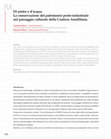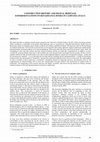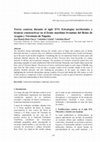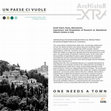Papers by Valentina Russo

International Seminar "War Gaps as Memory Sites. Conflicts, ruins, and urban voids in multilayere... more International Seminar "War Gaps as Memory Sites. Conflicts, ruins, and urban voids in multilayered contemporary cities", edited by Howayda Al-Harithy, Valentina Russo, Hulya Yuceer, November 4 to 6, 2024 at the Aula Magna of the Department of Architecture (Naples, Palazzo Gravina).
The conflicts of the twentieth century left scars still visible in the urban fabric of historic cities, referable not only to the presence of architecture and ruined sites, but also to the archaeological evidence that emerged as a result of the demolitions. Often, these areas are empty of meaning and deprived of material and immaterial relationships with the context and communities, which are not always able to grasp their intrinsic values.
What significance does this heritage take on today in the historic city? What strategies can be proposed for the construction of new urban narratives?
The Seminar - funded under the Bilateral Agreements between the University of Naples Federico II, the American University of Beirut and the Izmir Institute of Technology - involves the participation of scholars from national and international academic institutions who will explore aspects related to knowledge, conservation and the design of this "difficult" heritage.
Restauro Archeologico, special issue, 2023
2023 "Già chiamano in aiuto la chimica..." Il restauro da bottega a laboratorio scientifico e pra... more 2023 "Già chiamano in aiuto la chimica..." Il restauro da bottega a laboratorio scientifico e pratica di cantiere 1 Conoscenza, conservazione e valorizzazione del patrimonio architettonico Rivista del Dipartimento di Architettura dell'Università degli Studi di Firenze Knowledge, preservation and enhancement of architectural heritage
in «Cantiere Nervi. La costruzione di una identità. Storie, geografie, paralleli», Atti del Conve... more in «Cantiere Nervi. La costruzione di una identità. Storie, geografie, paralleli», Atti del Convegno Internazionale di Studi «Cantiere Nervi. La costruzione di un’identità» (Parma, Ferrara, Bologna, 24-26 novembre 2010), a cura di G. Bianchino e D. Costi, Skira, Milano 2012, pp. 180-184

Restauro Archeologico, Feb 3, 2023
The Amalfi Coast represents a unicum in which the complexity is due to the coexistence of natural... more The Amalfi Coast represents a unicum in which the complexity is due to the coexistence of natural singularities and multiple traces resulting from the adaptation made by man to the harsh orography and to the scarcity of resources. Included in the World Heritage List in 1997, the area of the UNESCO perimeter is placed at the centre of the programmatic guidelines of the Management Plan which articulates the objectives around the themes of knowledge, protection, conservation, enhancement, and communication of (and for) coastal cultural heritage. Given these premises, the contribution aims to present a critical balance between the prospects for intervention and the operations concretely defined for the conservation of the cultural landscape of the Amalfi Coast, paying attention to the fate of the proto-industrial heritage (paper mills, ironworks, mills, and hydraulic works), largely abandoned and which requires targeted strategies for the recognition of specificities and the mitigation of intrinsic vulnerabilities.

The International Archives of the Photogrammetry, Remote Sensing and Spatial Information Sciences, Jul 24, 2020
The paper describes an ongoing research project granted by the University of Naples Federico II (... more The paper describes an ongoing research project granted by the University of Naples Federico II (2017-2020) concerning masonry domes considered as visual poles in the historic urban landscape and as a constructively vulnerable built heritage. Studies focus on Renaissance domes in Campania region (Naples included) and combine established strategies with innovative ones for the knowledge of visible/invisible parts. Verticals and curved structures are investigated with a unitary approach, together with the pre-reinforcements placed during the construction phases or for later strengthening. These topics deal with issues crucial for the domes' study: firstly, the overlapping of inner and outer surfaces that hide structural elements and do not enable their comprehension. In addition, we must consider the recurring difficult inspection or inaccessibility due to the big dimensions and heights from the ground. All these factors, together with the fact that decorated surfaces are a limit for the traditional diagnosis, require new investigation strategiesremote and by non-destructive methodsso as to document the invisible both for emerging and for underground parts. A model for knowledge characterized by the interlacement of 'humanistic' interpretation and bottom-up/bottom-down surveys is discussed. The understanding of what is invisible to direct inspection is considered a stimulating frontier for proposing innovative dissemination tools for the comprehension of cultural heritage, able to reach new communicative horizons related to the construction of complex forms of architecture. The transposition of the research outcomes into digital "accessible" data aims at having impacts for sharing a broader cultural awareness of the built heritage historical constructive significance.

Storia urbana, Feb 1, 2015
Tra le piu antiche istituzioni napoletane, il Tribunale della Fortificazione (poi Mattonata e Acq... more Tra le piu antiche istituzioni napoletane, il Tribunale della Fortificazione (poi Mattonata e Acqua) ha controllato in ambito urbano l’insieme delle pratiche connesse alla manutenzione delle mura, di bastioni e torri, delle attrezzature idrauliche - acquedotti e fontane - nonche degli spazi aperti di giurisdizione pubblica dal Medioevo agli inizi del diciannovesimo secolo. L’ampia documentazione archivistica riferita all’organizzazione amministrativa, agli interventi sollecitati o imposti e, ancora, alle numerose figure di ingegneri e tavolari coinvolti tra la prima meta del Cinquecento e il 1805 nella progettazione e direzione delle opere, conservata nell’Archivio storico municipale di Napoli, e indagata nello scritto con riferimento al periodo compreso tra la meta del Cinquecento e il primo Settecento. Il puntuale controllo sulle condizioni delle strade e piazze, la costante pratica della manutenzione degli acquedotti, delle fontane cittadine, del corso delle acque piovane e delle pavimentazioni stradali come il mantenimento degli spazi pubblici liberi da costruzioni private trovano ampia dimostrazione nella ricca documentazione conservata e risparmiata dall’incendio che nel 1946 ha distrutto parte del corpus archivistico. Attraverso lo studio dei Banni, Appuntamenti e Conclusioni e analizzato in modo sistematico un tema di ricerca ancora non sufficientemente approfondito in letteratura, riguardante il ruolo e gli obiettivi che il governo vicereale attribuiva alla cura del patrimonio urbano collettivo nonche alle modalita tecniche con cui quest’ultima e condotta in eta barocca.
DOAJ (DOAJ: Directory of Open Access Journals), Nov 1, 2020
Supplemento di ArcHistoR 13/2020 a cura di Annunziata Maria Oteri Giuseppina Scamardì u n pa e s ... more Supplemento di ArcHistoR 13/2020 a cura di Annunziata Maria Oteri Giuseppina Scamardì u n pa e s e c i v u o l e Studi e prospettive per i centri abbandonati e in via di spopolamento o n e n e e d s a t o w n S t u d i e s a n d p e r s p e c t i v e s f o r a b a n d o n e d o r d e p o p u l a t e d s m a l l t o w n s
CRC Press eBooks, Sep 1, 2017

Sorrento historical center consists of an urban palimpsest, characterized by stratified forms of ... more Sorrento historical center consists of an urban palimpsest, characterized by stratified forms of architecture, ancient infrastructures and a complex natural landscape. Although the city was equipped with walls since the Roman Age, it was in the 15th and 16th centuries that they were modernized because of the new needs of the artillery. The Sorrento castle is part of this global strategy. It was built in 1459, transformed during the following centuries and demolished in 1843 because of the public requirement for a larger square and the advanced state of ruin of the fortification. This event left a deep trace in Sorrento history by corresponding to drastic changes at urban scale. Because of these considerations, the paper deepens the knowledge of the castle and the 19th century demolition considered as a turning point in Sorrento urban development, by changing irremediably the strong relationships between architecture and historical landscape.
in «Quale sostenibilità per il restauro?», Atti del XXX Convegno di Studi «Scienza e Beni Cultura... more in «Quale sostenibilità per il restauro?», Atti del XXX Convegno di Studi «Scienza e Beni Culturali», (Bressanone, 1-4 luglio 2014), Arcadia Ricerche, Venezia 2014, pp. 433-444.

STORIA URBANA, 2013
La dismissione, la trasformazione e la valorizzazione delle fortificazioni costituiscono, anche p... more La dismissione, la trasformazione e la valorizzazione delle fortificazioni costituiscono, anche per Napoli, temi trainanti nell'evoluzione urbana tra la seconda metŕ del XIX e la prima metŕ del XX secolo. Nella prima parte del saggio, incentrato sul periodo post-unitario, sono approfondite le motivazioni psicologiche, sociali ed economiche connesse all'annullamento di simboli "negativi" che conducono alla riconfigurazione di ampie parti urbane: a tale quadro d'insieme possono riferirsi gli interventi di tabula rasa effettuati sulla cinta bastionata circostante Castelnuovo dalla fine del XV secolo. Lo smantellamento dei bastioni e delle fabbriche di uso militare racchiuse nel recinto fortificato assume un ruolo centrale nella configurazione della cittŕ del Novecento e, con essa, della piazza Municipio, come confermano anche disegni di legge e dibattiti parlamentari avviati fin dal 1861. La seconda parte del saggio affronta le vicende delle mura aragonesi, che sa...

The historical strong relationship between the eastern coast of Spain and southern part of Italia... more The historical strong relationship between the eastern coast of Spain and southern part of Italian Peninsula has been a common issue over different civilizations from Phoenicians, Greeks and Romans up to the most recent modern kingdoms. Considering this set of connections based on trade routes and territorial bilateral interests, the western shores of Mare Nostrum have been key-points of a dense network of military and economical strategies. The dynamics of extensive territorial control have left interesting examples of costal watchtowers both in the Sorrento Peninsula, near Naples (Italy) and in the East coast of Valencia (Spain). The process of towers construction begins at early stages of Middle Age and, from the 16th century it runs up into a systemic control of the coastline, thanks to the reuse of obsolete fortified elements and new building-site procedures. In the paper, the authors aim at highlighting the territorial relationships among a number of towers built during the 16...
Interdisciplinary conservation issues of an “unstable” architecture: researches about the bell to... more Interdisciplinary conservation issues of an “unstable” architecture: researches about the bell tower of St. Augustine the Greater in Naples Valentina Russo1; Piergiulio Cappelletti2; Giovanna Ceniccola1; Marco D’Amore2; Raffaele Landolfo3; Francesco Portioli3 1 University of Naples Federico II, Dept. of Architecture, Naples, Italy; 2 University of Naples Federico II, Dept. of Earth Sciences, Environment and Resources, Naples, Italy; 3 University of Naples Federico II, Dept. of Structures for Engineering and Architecture, Naples, Italy

FeDOA Press makes every effort to ensure the accuracy of all the information (the "Content") cont... more FeDOA Press makes every effort to ensure the accuracy of all the information (the "Content") contained in the publications on our platform. FeDOA Press, our agents, and our licensors make no representations or warranties whatsoever as to the accuracy, completeness, or suitability for any purpose of the Content. Versions of published FeDOA Press and Routledge Open articles and FeDOA Press and Routledge Open Select articles posted to institutional or subject repositories or any other thirdparty website are without warranty from FeDOA Press of any kind, either expressed or implied, including, but not limited to, warranties of merchantability, fitness for a particular purpose, or non-infringement. Any opinions and views expressed in this article are the opinions and views of the authors, and are not the views of or endorsed by FeDOA Press. The accuracy of the Content should not be relied upon and should be independently verified with primary sources of information. FeDOA Press shall not be liable for any losses, actions, claims, proceedings, demands, costs, expenses, damages, and other liabilities whatsoever or howsoever caused arising directly or indirectly in connection with, in relation to or arising out of the use of the Content.

The conservation of abandoned urban sites, increasingly widespread all over the Italian territory... more The conservation of abandoned urban sites, increasingly widespread all over the Italian territory and mainly along the mountain slopes, represents a complex cultural challenge which includes cultural, psychological, economic, technical, as well as aesthetic and social issues. While the sudden or progressive abandonment has guaranteed, in some ways, the preservation of authentic material values, at the same time the possibility of exploiting the places again through the restoration of architecture and the improvement of conditions of accessibility is functional also for the protection of the built heritage and the intangible values that characterize it. Starting from this, the contribution focuses on a synoptic framework of interventions and strategies aimed at the redevelopment of partially or totally abandoned urban sites in Italy, concentrating attention on the goals of diverse choices for safeguarding historic heritage. The framework aims at defining an atlas of practices that, w...
(with A. Zinno, V. Russo, E. Vassallo, G.P. Lignola), in Proc. 1st Middle East Conference on Smar... more (with A. Zinno, V. Russo, E. Vassallo, G.P. Lignola), in Proc. 1st Middle East Conference on Smart Monitoring, Assessment and Rehabilitation of Civil Structures (SMAR 2011), (Dubai, UAE, American University, 8 – 10 Febbraio 2011), a cura di Masoud Motavalli, Bernadette Havranek and Elias Saqan, Paper Id. 124, 2011.











Uploads
Papers by Valentina Russo
The conflicts of the twentieth century left scars still visible in the urban fabric of historic cities, referable not only to the presence of architecture and ruined sites, but also to the archaeological evidence that emerged as a result of the demolitions. Often, these areas are empty of meaning and deprived of material and immaterial relationships with the context and communities, which are not always able to grasp their intrinsic values.
What significance does this heritage take on today in the historic city? What strategies can be proposed for the construction of new urban narratives?
The Seminar - funded under the Bilateral Agreements between the University of Naples Federico II, the American University of Beirut and the Izmir Institute of Technology - involves the participation of scholars from national and international academic institutions who will explore aspects related to knowledge, conservation and the design of this "difficult" heritage.
The conflicts of the twentieth century left scars still visible in the urban fabric of historic cities, referable not only to the presence of architecture and ruined sites, but also to the archaeological evidence that emerged as a result of the demolitions. Often, these areas are empty of meaning and deprived of material and immaterial relationships with the context and communities, which are not always able to grasp their intrinsic values.
What significance does this heritage take on today in the historic city? What strategies can be proposed for the construction of new urban narratives?
The Seminar - funded under the Bilateral Agreements between the University of Naples Federico II, the American University of Beirut and the Izmir Institute of Technology - involves the participation of scholars from national and international academic institutions who will explore aspects related to knowledge, conservation and the design of this "difficult" heritage.